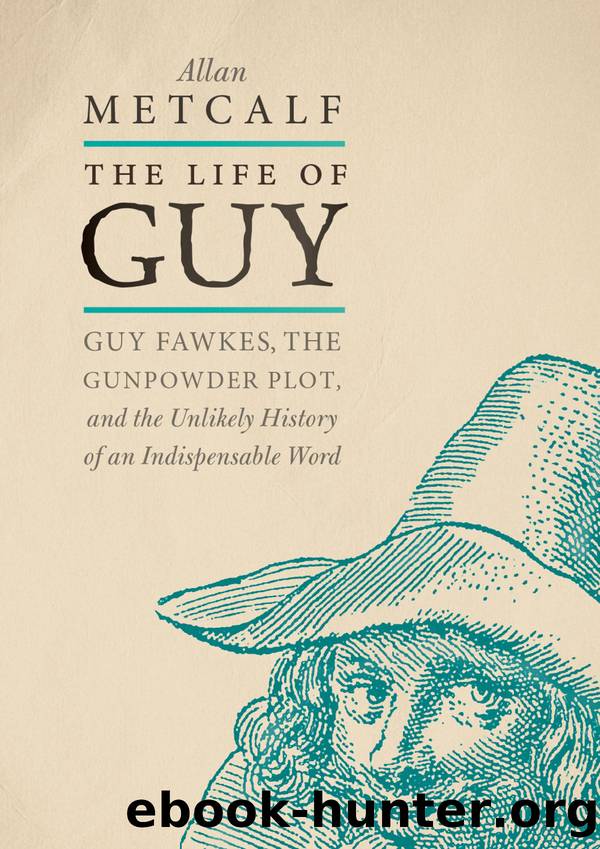The Life of Guy by Metcalf Allan;

Author:Metcalf, Allan; [Metcalf, Allan;]
Language: eng
Format: epub
ISBN: 9780190669201
Publisher: OxfordUP
Published: 2019-09-15T00:00:00+00:00
See, here, the Popish Pouder-plots fair thriving,
Fauks and his Father-Satan sit contriving
The fatal-Instruments, to puffe and blow
Hell out of Earth, a State to over-throw,
At Once, for All. . . .
Faukes has now become no less than the son of the devil.
Among other ways of remembering November 5, in the 1620s some church parishes began observing it as a day for charity, collecting funds to support hospitals, education, even clothing for the poor.
At this early stage, the name Guy isnât a magic word. The day is called Gunpowder Treason Day, or Gunpowder Night, or just Bonfire Night, focusing on Catholics and the pope instead of Guy Fawkes alone. When the commemoration was sermons and church bells, Fawkes did not figure prominently. He was a strong, staunch, and courageous Catholic, but not any kind of theologian, preacher, or prophet, and not the mastermind of the plot. Unlike the pope and other high officials, Fawkes was known not for his rank or position but only for his acts on the night of the original Gunpowder Day.
But thanks to the bonfires and fireworks, reflecting benevolently what Fawkes had intended malevolently, Guy was far from forgotten. A gradual change in focus began in the 1630s, thanks to the bonfires.
Bonfires had been features of English celebrations long before 1605, so they fit perfectly with the new holiday of November 5. And that began to turn attention to Guyââthe Guy,â that is, beginning the transformation from terrorist to stuffed effigy, a transformation crucial to the term we use nowadays.
Even at bonfires, though, it took a little while for Guy, or rather his likeness, to make an appearance. For example, in Norwich, Doyle notes that âup to 1625, that town burned in its bonfire not only debris and wood but also a host of models or relics of popery, including an altarstone, a crucifix, a habit, a lectionary, a pax, and a surplice.â No Guy yet.
During the English civil war of 1642â1651, both sides viewed the November 5 celebration as their own, so even with regime change it continued without interruption. In 1647, as the civil war was coming to an end with King Charles in prison, Londoners were treated to a spectacular series of fireworks, courtesy of a gunner named George Browne, including
Faux with his darke Lanthorne, and many fire-boxes, lights, and lamps, ushering the Pope into England, intimating the full Plot to destroy Englands King and Parliament.
Again, though, the last name Faux rather than Guy was used to refer to the devilish traitor. Guy by itself was still more often the name or title of many a French hero. But then came the practice of making a combustible caricature effigy of Guy Fawkes and parading it through the streets before being tossed on the Gunpowder Treason Day bonfire along with âthe guyâs companion âthe pope.â
Another reason for thanksgiving on November 5 came in 1688. That was when the Protestant Prince of Orange, William III, landed on the coast of England with a fleet of ships and a large army.
Download
This site does not store any files on its server. We only index and link to content provided by other sites. Please contact the content providers to delete copyright contents if any and email us, we'll remove relevant links or contents immediately.
Cecilia; Or, Memoirs of an Heiress — Volume 1 by Fanny Burney(32434)
Cecilia; Or, Memoirs of an Heiress — Volume 2 by Fanny Burney(31871)
Cecilia; Or, Memoirs of an Heiress — Volume 3 by Fanny Burney(31854)
The Lost Art of Listening by Michael P. Nichols(7406)
Asking the Right Questions: A Guide to Critical Thinking by M. Neil Browne & Stuart M. Keeley(5635)
We Need to Talk by Celeste Headlee(5542)
On Writing A Memoir of the Craft by Stephen King(4863)
Dialogue by Robert McKee(4321)
Pre-Suasion: A Revolutionary Way to Influence and Persuade by Robert Cialdini(4148)
I Have Something to Say: Mastering the Art of Public Speaking in an Age of Disconnection by John Bowe(3840)
Elements of Style 2017 by Richard De A'Morelli(3307)
The Book of Human Emotions by Tiffany Watt Smith(3238)
Fluent Forever: How to Learn Any Language Fast and Never Forget It by Gabriel Wyner(3028)
Name Book, The: Over 10,000 Names--Their Meanings, Origins, and Spiritual Significance by Astoria Dorothy(2939)
Good Humor, Bad Taste: A Sociology of the Joke by Kuipers Giselinde(2903)
Why I Write by George Orwell(2874)
The Art Of Deception by Kevin Mitnick(2736)
The Grammaring Guide to English Grammar with Exercises by Péter Simon(2710)
Ancient Worlds by Michael Scott(2625)
